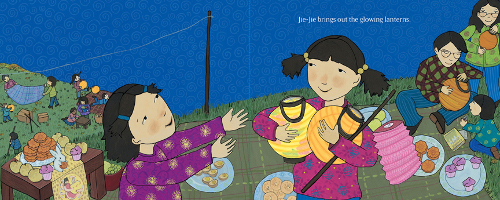Seven Questions Over Breakfast with Richard Holland
 Tuesday, November 30th, 2010
Tuesday, November 30th, 2010
 I pulled this “seven questions over breakfast” illustrator interview series out of the air in 2008 (with the wonderful Jeremy Tankard as my first victim) precisely for folks like British illustrator Richard Holland, visiting me this morning for a coffee
I pulled this “seven questions over breakfast” illustrator interview series out of the air in 2008 (with the wonderful Jeremy Tankard as my first victim) precisely for folks like British illustrator Richard Holland, visiting me this morning for a coffee
Q & A. Essentially, I wanted to have a covers-the-basics questionnaire handy in order to shine the spotlight on new illustrators in the field of children’s lit—to get a quick overview of what they’ve done and where they’re heading—and Richard fits snugly into that category. New, that is. He’s illustrated five titles thus far in his career, and it was his collage work on Jan Mark’s The Museum Book and Martin Jenkins’s The Time Book (both released by Candlewick in 2007 and 2009, respectively, after first being released in the UK) that caught my attention. This year, he also illustrated Tanya Landman’s Mary’s Penny (also Candlewick), a re-telling of a traditional fable, pictured below. (“Soft colors and the lightest of lines echo the gossamer touch used to deliver the feminist moral,” wrote Publishers Weekly.)
 If you haven’t seen The Museum Book and The Time Book (both nonfiction titles), you’re in for a treat. I suppose it all comes down to personal preference, but I say that, even if you’re not a fan of collage, Richard might change your ways. Publishers Weekly wrote about his mixed-media collage work in The Museum Book, “Holland…jolts readers…with his mixed-media collages, which sparingly employ color and liberally combine what look like Victorian engravings, pencil sketches, Gorey-like figures, and photos of various locales. His stylish compositions play with perspective, type and design, making excellent use of the vertically oriented pages…” These are spreads to pore over, taking in Richard’s creative interpretations of our histories of both collecting and watching our clocks. Read the rest of this entry �
If you haven’t seen The Museum Book and The Time Book (both nonfiction titles), you’re in for a treat. I suppose it all comes down to personal preference, but I say that, even if you’re not a fan of collage, Richard might change your ways. Publishers Weekly wrote about his mixed-media collage work in The Museum Book, “Holland…jolts readers…with his mixed-media collages, which sparingly employ color and liberally combine what look like Victorian engravings, pencil sketches, Gorey-like figures, and photos of various locales. His stylish compositions play with perspective, type and design, making excellent use of the vertically oriented pages…” These are spreads to pore over, taking in Richard’s creative interpretations of our histories of both collecting and watching our clocks. Read the rest of this entry �

 He’s finally located a sock. He’s been lurching around and searching for one, you see, in an October release from Henry Holt and Company,
He’s finally located a sock. He’s been lurching around and searching for one, you see, in an October release from Henry Holt and Company, 

 It’s another year. Another Thanksgiving. Harold and I are here again (it seems I’ve done this the past couple of years, so I may as well make it a 7-Imp tradition) to say: May you, dear readers, go forth and eat
It’s another year. Another Thanksgiving. Harold and I are here again (it seems I’ve done this the past couple of years, so I may as well make it a 7-Imp tradition) to say: May you, dear readers, go forth and eat 







 This very funny teeny-tiny octopus with the enormous tentacle (at least he doesn’t look like it’s too terribly painful) comes from Canadian illustrator
This very funny teeny-tiny octopus with the enormous tentacle (at least he doesn’t look like it’s too terribly painful) comes from Canadian illustrator 